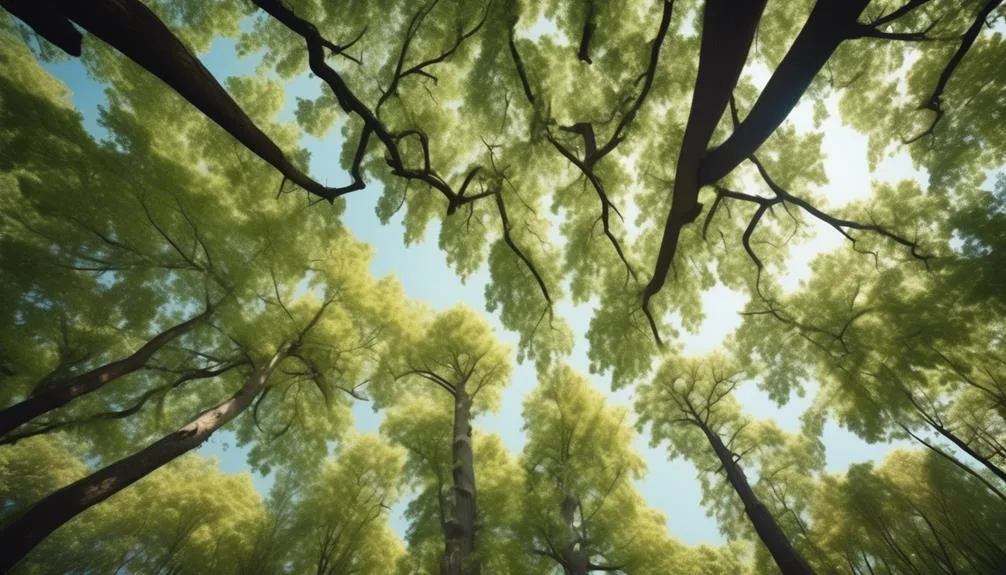When you walk through a hickory forest, it's like entering a busy city where every tree, shrub, and animal plays a crucial role in the web of life.
Hickory trees are not just beautiful; they are vital for local wildlife. They provide shade, shelter, and food for many creatures. Their impact goes beyond what meets the eye, contributing to the whole ecosystem.
Let's explore how these remarkable trees enhance the biodiversity of their local habitats.
Shade and Shelter for Wildlife
Hickory trees provide essential shade and shelter for a diverse array of local wildlife, creating a vital oasis within the forest ecosystem. Their broad canopies offer protection from the scorching sun and heavy rains, while their sturdy trunks and branches provide nesting sites and refuge for countless creatures.
In the realm of wildlife conservation, these trees play a crucial role in preserving habitats for various species. Birds such as the Pileated Woodpecker and the Red-Shouldered Hawk find sanctuary in the lofty branches, while smaller mammals like squirrels and chipmunks rely on hickory trees for both food and shelter.
The preservation of hickory tree habitats is therefore fundamental to maintaining the rich biodiversity of local ecosystems, ensuring that these vital refuges continue to support a wide range of wildlife.
Nutrient-Rich Food Source
A rich source of essential nutrients for various wildlife species, the hickory tree's abundant nuts play a crucial role in sustaining local biodiversity. These nutrient-rich nuts not only provide sustenance for a wide array of wildlife but also contribute to soil enrichment.
As wildlife forage for hickory nuts, they inadvertently drop and bury some, aiding in tree regeneration and maintaining ecosystem balance. The fallen nuts decompose, releasing valuable nutrients into the soil, which in turn supports the growth of other plants and organisms. This process creates a cycle of nutrient exchange, benefitting the entire ecosystem.
Additionally, the hickory nuts are a vital food source for many small mammals and birds, ensuring their survival and contributing to the overall diversity of the local wildlife community.
Diverse Microhabitats
How do diverse microhabitats within hickory tree ecosystems contribute to the overall biodiversity of the local environment?
Diverse microhabitats play a crucial role in enhancing the overall biodiversity within hickory tree ecosystems. Here's how it happens:
- Soil Enrichment and Fungal Symbiosis
The fallen leaves and decaying hickory nuts create a rich layer of organic matter on the forest floor, enriching the soil and providing an ideal environment for fungal symbiosis. This symbiotic relationship between fungi and plants supports a diverse range of microorganisms, including bacteria and fungi themselves. These microorganisms contribute to the nutrient cycling and decomposition processes, further enriching the soil and creating a favorable environment for other organisms.
- Forest Understorey and Plant Diversity
The enriched soil supports a thriving forest understorey, which refers to the layer of vegetation that grows beneath the main canopy of trees. This understorey creates varied niches for a diverse array of plant species to flourish. Different microhabitats within the hickory tree ecosystem, such as areas with more sunlight or areas with more moisture, provide unique conditions that allow a wide variety of plant species to coexist. This diversity of plant species not only enhances the overall biodiversity but also provides habitat and food sources for a range of animals, including insects, birds, and mammals.
Support for Insect and Bird Populations
Supporting diverse insect and bird populations, the varied microhabitats within hickory tree ecosystems create ideal conditions for a thriving community of wildlife. Hickory trees play a crucial role in supporting insect and bird populations through pollination support and maintaining ecological balance.
The diverse array of insects, such as bees, butterflies, and beetles, are attracted to the hickory tree's flowers, aiding in the pollination of surrounding flora. This process not only ensures the reproduction of various plant species but also contributes to the ecological balance of the entire ecosystem.
Additionally, the canopy and branches of hickory trees provide an abundant food source and nesting sites for birds, thus supporting the food chain and enhancing habitat diversity. As a result, hickory trees significantly contribute to the overall health and richness of local insect and bird populations.
Contribution to Ecosystem Resilience
The intricate network of microhabitats within hickory tree ecosystems not only supports diverse insect and bird populations but also contributes significantly to the resilience of the entire ecosystem. This resilience is vital for maintaining ecological balance and ensuring the sustainability of the various species interactions within the ecosystem.
Here's how hickory trees bolster ecosystem resilience:
- Enhanced Soil Stability
The deep root systems of hickory trees help prevent soil erosion, maintaining soil stability even during extreme weather events.
- Nutrient Cycling
The leaf litter and decomposing organic matter from hickory trees contribute to nutrient cycling, enriching the soil and supporting the growth of diverse plant species.
Hickory trees play a pivotal role in fortifying the ecosystem's ability to withstand disturbances, fostering a dynamic and resilient environment for all its inhabitants.
Conclusion
In summary, hickory trees significantly contribute to local biodiversity by providing shelter, food, and diverse habitats for wildlife. Recognizing their vital role can guide us in preserving these essential elements of our natural environment.
How can we ensure the continued protection of hickory trees and the ecosystems they support?
Mark Hoffman is a dedicated arborist and tree care specialist with over a decade of experience. His love for trees began when he visited Yosemite National Park as a teenager and was awestruck by the giant sequoias. Mark pursued his passion by studying forestry at Michigan Technological University, where he earned a Bachelor of Science degree.
Since then, he has worked tirelessly in the field of arboriculture, helping to preserve and protect trees in his community. His expertise and dedication have made him a respected leader in the industry and a valuable resource for anyone seeking advice on tree care.
